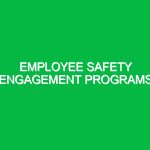Introduction to Workplace Safety in Educational Institutions
Workplace safety in educational institutions encompasses a broad range of practices and protocols designed to ensure the well-being of both students and staff. It is a vital aspect of the Health, Safety, and Environment (HSE) domain, which aims to create an environment that minimizes risks and maximizes productivity. Educational institutions, including schools, colleges, and universities, are unique environments where various hazards can arise—from physical risks in laboratories to health concerns in crowded classrooms. Understanding these hazards is crucial for fostering a safe learning atmosphere.
The relevance of workplace safety in educational institutions cannot be overstated. A safe environment promotes not only physical well-being but also mental health, enhancing the overall educational experience. For instance, when students and teachers feel secure, they are more likely to engage fully in their educational pursuits. Moreover, incidents related to workplace safety can lead to significant legal ramifications and financial burdens, underscoring the importance of proactive measures. As we delve deeper into this topic, we will explore the potential hazards, safety precautions, and regulations that govern workplace safety in educational settings.
Identifying Hazards and Risks in Educational Institutions
Common Hazards in Educational Environments
Educational institutions face a variety of hazards that can threaten the safety of students and staff. These hazards can be broadly categorized into physical hazards, chemical hazards, biological hazards, ergonomic risks, and psychosocial risks.
Physical Hazards
Physical hazards are perhaps the most visible risks in educational settings. They include slips, trips, and falls, which can occur due to wet floors, uneven surfaces, or cluttered hallways. For instance, a simple spill in a science lab can lead to serious injuries if not addressed promptly. Moreover, inadequate lighting in corridors and classrooms can increase the risk of accidents, particularly in older buildings.
Chemical Hazards
Chemical hazards often stem from the use of various substances in science labs and art rooms. Exposure to toxic chemicals can pose serious health risks, including respiratory issues and skin irritations. For example, a high school chemistry lab may use hazardous materials that require stringent safety measures, such as proper ventilation and personal protective equipment (PPE).
Biological Hazards
Biological hazards relate to exposure to infectious agents, which can be particularly concerning in schools with large populations. The spread of illnesses like influenza or COVID-19 can disrupt learning and pose serious health risks. Institutions must implement hygiene protocols, such as regular handwashing and sanitization, to mitigate these risks.
Ergonomic Risks
Ergonomic risks are often overlooked but can significantly impact the health of staff and students. Poorly designed workstations, such as those used by administrative staff or computer lab users, can lead to musculoskeletal disorders. For instance, prolonged use of a computer without ergonomic adjustments can result in back pain and repetitive strain injuries.
Psychosocial Risks
Psychosocial risks encompass stress, bullying, and other mental health concerns. A safe educational environment must address these issues, promoting mental well-being alongside physical safety. Schools should have clear policies and support systems in place to help students and staff navigate these challenges.
Safety Precautions and Best Practices
Implementing Safety Measures in Educational Institutions
To effectively manage workplace safety in educational institutions, it is essential to implement comprehensive safety measures that address identified hazards. Below are actionable strategies that schools and universities can adopt to enhance safety.
Regular Safety Audits
Conducting regular safety audits helps identify potential hazards and assess the effectiveness of existing safety protocols. Schools can form safety committees comprising staff, students, and parents to evaluate risks and recommend improvements. For instance, a university might schedule biannual safety audits to ensure that laboratories meet safety standards and that emergency exits are accessible.
Employee Training and Awareness
Training is a critical component of workplace safety. Educational institutions should provide ongoing safety training for staff, focusing on emergency procedures, proper handling of hazardous materials, and the importance of using PPE. Engaging students in safety awareness programs can also foster a culture of safety. A personal anecdote from a former high school teacher illustrates this: after implementing monthly safety drills, students became more aware of their surroundings and were better prepared to respond to emergencies.
Establishing Clear Safety Protocols
Institutions must establish clear safety protocols that are easily accessible to all members of the school community. This includes emergency response plans, procedures for reporting hazards, and guidelines for using chemicals in laboratories. For example, a well-documented emergency response plan might outline evacuation routes during a fire drill, ensuring that everyone knows their responsibilities in such situations.
Promoting a Culture of Safety
Creating a culture of safety involves encouraging open communication about safety concerns. Institutions should foster an environment where students and staff feel comfortable reporting hazards without fear of retribution. Regular feedback sessions can help identify areas for improvement. For instance, a college that encourages students to speak up about uncomfortable classroom conditions may uncover issues related to overcrowding or inadequate resources.
Investing in Infrastructure Improvements
Educational institutions should invest in infrastructure improvements to minimize risks. This includes upgrading lighting, maintaining walkways, and ensuring that laboratories are equipped with adequate safety equipment like eyewash stations and fire extinguishers. A personal story from a university campus illustrates this point: after upgrading their lab facilities to include modern safety equipment, the institution significantly reduced incidents related to chemical exposure.
Regulations and Standards Governing Workplace Safety
Understanding the Legal Framework
Workplace safety in educational institutions is governed by various regulations and standards, which vary by region but generally align with national and international guidelines. Understanding these regulations is crucial for compliance and ensuring a safe environment.
Occupational Safety and Health Administration (OSHA)
In the United States, the Occupational Safety and Health Administration (OSHA) sets forth regulations that apply to educational institutions. These regulations mandate safe working conditions and require schools to comply with specific safety standards. For example, OSHA‘s General Duty Clause requires institutions to provide a workplace free from recognized hazards that could cause death or serious physical harm.
Local and State Regulations
In addition to federal regulations, local and state laws may impose further safety requirements. Educational institutions should stay informed about these regulations, as they often address unique community issues. For instance, a state might have specific guidelines for managing asbestos in older school buildings, necessitating regular inspections and remediation efforts.
National Fire Protection Association (NFPA)
The National Fire Protection Association (NFPA) provides codes and standards that educational institutions must adhere to regarding fire safety. Compliance with NFPA standards ensures that schools have adequate fire prevention measures, such as alarm systems and fire drills, in place. Regular fire safety inspections can help institutions remain compliant and ensure a safe environment for all.
Environmental Protection Agency (EPA)
The Environmental Protection Agency (EPA) also plays a role in regulating workplace safety, particularly concerning chemical hazards. Schools must adhere to EPA guidelines regarding the safe storage and disposal of hazardous materials. A failure to comply can lead to significant fines and health risks for the entire school community.
Conclusion
Workplace safety in educational institutions is a multifaceted issue that demands attention from all stakeholders. By identifying potential hazards, implementing effective safety measures, and adhering to established regulations, educational institutions can create a safe environment conducive to learning. It is imperative that schools, colleges, and universities prioritize workplace safety as a core value, recognizing its profound impact on the educational experience. As we move forward, continuous improvement in safety practices will not only protect individuals but also foster a culture of responsibility and care within our educational institutions.


